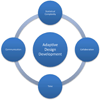A conceptual model for the development process of confirmatory adaptive clinical trials within an emergency research network
- PMID: 28135827
- PMCID: PMC5446276
- DOI: 10.1177/1740774516688900
A conceptual model for the development process of confirmatory adaptive clinical trials within an emergency research network
Abstract
Background: Adaptive clinical trials use accumulating data from enrolled subjects to alter trial conduct in pre-specified ways based on quantitative decision rules. In this research, we sought to characterize the perspectives of key stakeholders during the development process of confirmatory-phase adaptive clinical trials within an emergency clinical trials network and to build a model to guide future development of adaptive clinical trials.
Methods: We used an ethnographic, qualitative approach to evaluate key stakeholders' views about the adaptive clinical trial development process. Stakeholders participated in a series of multidisciplinary meetings during the development of five adaptive clinical trials and completed a Strengths-Weaknesses-Opportunities-Threats questionnaire. In the analysis, we elucidated overarching themes across the stakeholders' responses to develop a conceptual model.
Results: Four major overarching themes emerged during the analysis of stakeholders' responses to questioning: the perceived statistical complexity of adaptive clinical trials and the roles of collaboration, communication, and time during the development process. Frequent and open communication and collaboration were viewed by stakeholders as critical during the development process, as were the careful management of time and logistical issues related to the complexity of planning adaptive clinical trials.
Conclusion: The Adaptive Design Development Model illustrates how statistical complexity, time, communication, and collaboration are moderating factors in the adaptive design development process. The intensity and iterative nature of this process underscores the need for funding mechanisms for the development of novel trial proposals in academic settings.
Keywords: Adaptive clinical trials; Strength–Weaknesses–Opportunities–Threats; confirmatory-phase clinical trials; mixed methods; neurology clinical trials; qualitative research.
Conflict of interest statement
Dr. Berry reported that he is part owner of Berry Consultants LLC, a statistical consulting firm that specializes in the design, implementation, and analysis of Bayesian adaptive clinical trials for pharmaceutical manufacturers, medical device companies, and academic institutions. Dr. Lewis reported that he is the senior medical scientist for Berry Consultants LLC; both Dr. Lewis and the Los Angeles Biomedical Research Institute are compensated for his time.
Figures
References
-
- Food and Drug Administration. Critical Path Opportunities List. 2006.
-
- Bretz F, Koenig F, Brannath W, et al. Adaptive designs for confirmatory clinical trials. Stat Med. 2009;28:1181–1217. - PubMed
MeSH terms
Grants and funding
LinkOut - more resources
Full Text Sources
Other Literature Sources


